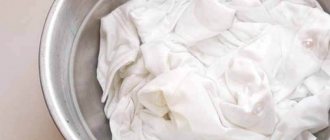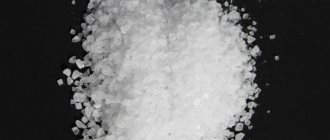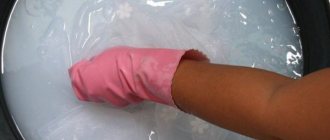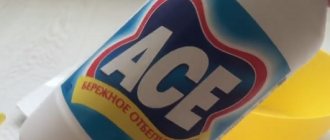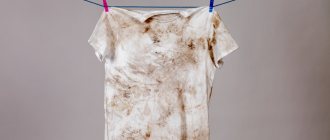If there is a need to bleach white synthetic clothes or underwear with lace inserts at home, you need to decide what products will be used for this. Their choice, first of all, depends on what defect you have to cope with:
- remove stains;
- refresh gray things;
- remove yellowness.
You can whiten synthetics, including removing stains, either using special factory products - bleaches and stain removers, or using “grandmother’s secrets”.
How can you not bleach synthetics?
Sometimes publications contain advice on bleaching white items, which are absolutely not suitable for synthetic fabrics.
Synthetics must not be subjected to the following manipulations:
- boil and wash at high temperature;
- soak or wash with products containing chlorine;
- dry in direct sunlight.
- squeeze after bleaching.
Chlorine-containing bleaches have an unpredictable effect on synthetics and in most cases lead to yellowing of the fabric. Drying in the sun has the same effect. But boiling can lead to deformation or complete damage to the item.
How to bleach a white blouse if it has turned gray due to the type of fabric
First, we will tell you how and with what you can bleach a blouse if it has turned gray, depending on the material of the sewing.
- Synthetics
Synthetics include polyester, fleece, and acrylic. If you decide to bleach a gray blouse with bleach from the store, you should choose ones that do not contain chlorine. For any type of bleaching, chemical or folk, the water temperature should not be higher than 40 degrees. Among the folk remedies for synthetic blouses you can use: potassium permanganate, ammonia, soda, peroxide, boric acid, salt.
- Whiten Silk White Blouse
Under no circumstances should you try to bleach a silk blouse if it has turned gray with products that contain at least a little chlorine. Also, do not rub the silk blouse or twist it too much. If you don’t know how to bleach a white silk blouse if it has turned gray, then you can safely resort to such remedies as ammonia, sea salt, citric acid, soda, peroxide.
- Wool blouses
Aggressive bleaching agents should not be used on wool. Washing at high temperatures and strong spinning are contraindicated. Peroxide, soda, ammonia, and salt are suitable for bleaching woolen blouses.
- Cotton and linen
Cotton and linen are very durable materials that are very difficult to return to their original whiteness, as well as to remove stubborn stains. Only repeated use of vinegar, ammonia, potassium permanganate or turpentine can cope with this task.
We return white color to gray things
There is a chance to bleach gray synthetics using regular salt. To do this, things are soaked in warm water with added salt - 600 g is mixed in 10 liters of water - after which they need to be rinsed well and washed with powder.
Another way: using soda and ammonia. 10 tablespoons of soda and 2 tablespoons of ammonia (3%) are diluted in 10 liters of warm water, the clothes are soaked for several hours (from 3 or more). After soaking, you need to wash with powder to wash out the softened particles that give the fabric a grayish tint.
Advice
If the fabric has turned gray from prolonged use or frequent careless washing, it is unlikely to be bleached. In addition, pellets form on the surface of such clothes, which also give an unkempt appearance, so “reanimating” them will still not give the expected effect.
Remember
I told you how to bleach a shirt. To make the process easy and simple, I’ll give you a few more tips:
- Sort things. Wash only white with white, colored with colored, otherwise things will fade.
- Do not use bleach frequently. Frequent use of aggressive agents will damage the tissue. Wash with it only as needed.
- Boil with laundry soap. Boil the laundry with soap over a fire - it will turn white. You can also add a little washing powder to eliminate the smell of laundry soap.
- Soak with hydrogen peroxide. This is a non-aggressive remedy. Suitable even for delicate fabrics.
- Use ammonia. It perfectly removes even old stains on white clothes.
- See label directions. Some fabrics require delicate care, so boiling or chlorine should not be used.
If you have any questions, ask them in the comments. And don't forget to watch the video in this article
How to remove yellowness?
White items can turn yellow under the influence of many factors. Sometimes it is quite easy to restore the original whiteness at home, sometimes you have to make an effort, and there are cases when it will no longer be possible to restore the original color, for example, when synthetic fibers have entered into a chemical reaction with chlorine.
Causes of yellowing:
- organic particles;
- traces of perfume or cologne;
- washing in water with a high content of magnesium salts;
- use of untreated water (with rust);
- not thoroughly rinsing after washing (including if the machine’s filter is clogged);
- washing white items with colored laundry powder;
- mold.
Organic particles are traces of our body on clothing. This is not only sweat, but also dead epidermis. If you wear a white item at least once and do not wash it, and then put it in a closet for long-term storage, it will most likely turn yellow. The same thing happens if things are poorly washed after use. You can whiten such yellowness using ordinary laundry soap.
- Soak clothes in cold or slightly lukewarm water for several hours.
- Rub with laundry soap (72%) to obtain a rich, dense foam.
- Pour hot water and soak for about another hour.
- Wash and rinse thoroughly.
- Rub with soap again and repeat washing.
Advice
Poorly washed or rinsed items are more difficult to wash, and the procedure may have to be repeated several times.
Small yellow spots that appear some time after washing may well be mold. After all, mold on things can be yellow and whitish, and not just black. To deal with such stains, you can use ammonia. For these purposes, both a technical aqueous solution of ammonia (25%) and the well-known ammonia alcohol, a 10% solution, are suitable. It is used as follows:
- in 10 liters of warm water dissolve 1 tablespoon of a 25 percent solution or 4 tablespoons of three percent ammonia;
- things are soaked for several hours and then washed in the usual way;
- When washing, in addition to soap or powder, you can also add ammonia, but in a smaller proportion.
We recommend: Is it possible to wash a sleeping bag in a machine? Modes, temperature, spin and other tips
The same bleaching method is used if the water contains a high content of magnesium salts.
Advice
Ammonia can be added during washing for prevention. Then yellowness does not appear on the clothes.
If yellowness appears from washing in water that has not been treated with rust, in addition to ammonia, you need to add hydrogen peroxide: 200 ml per 10 liters of water. There are two more recipes that can help cope with this problem:
- soaking in sulfur-containing solutions;
- use of peroxide bleaches.
A sulfur-containing solution can be prepared from ordinary mustard (powder). 100 g of mustard is thoroughly mixed in a small amount of water and then diluted in 10 liters. Things are soaked and then washed in the usual way. The water for soaking should be as hot as possible, so this method is not suitable for clothes that can be washed up to 50 ºC. More effective is the use of peroxide bleaches.
If possible, you can bleach clothes with sodium hydrosulfite - 2 tablespoons per 10 liters of water. This drug is used to soften water in boilers, so it is sometimes available in the households of residents of private houses. If it is not available, 30 percent hydrogen peroxide (perhydrol or hydroperite) or ordinary three percent peroxide is suitable: 30 ml of hydrogen peroxide or 2 tablets of hydroperite are added to 10 liters of water at a temperature of 30 ºC. To enhance the reaction, you can add a little soda ash. Synthetics are soaked in the prepared solution for 20-30 minutes. Soaking is done in plastic containers.
Removing stains
For any synthetics, except acetate fabrics, the following mixture is used to remove stains: 5 parts alcohol, 5 parts tartaric acid, 2 parts citric acid. The result of mixing should be a paste. It is applied to the stain and rubbed in 5-10 minutes before washing.
A few more recommendations for removing stains from light-colored synthetics.
- Sweat stains can be washed off if 2 aspirin tablets are crushed and dissolved in 100 ml of cold water, and the resulting solution is applied to the contaminated areas 2-3 hours before washing.
- Grease stains are removed with salt or chalk. Chalk powder or salt is rubbed into the stain, and after a few hours it is removed with a brush. This method is only suitable for fresh stains.
- Ink stains are removed by soaking and washing the stained area in fresh milk or curdled milk.
- You can try to remove the resulting rust stain with lemon. A lemon wrapped in gauze is applied to the stain and pressed with an iron.
We recommend: How to wash a coat at home without any problems?
Chemicals for whitening synthetics and removing stains
Chlorine-containing bleaches should not be used on synthetics. However, today there are effective products on sale that can bleach fabric well and do not damage synthetic fibers.
Here are a few products that have proven their effectiveness and are suitable for synthetics.
- Amway Pre Wash Spray. Apply to fabric and wipe with a sponge.
- Antipyatin soap. Things are soaped 10-15 minutes before washing. To enhance the effect, you can add soap to the powder.
- Amway SA8 powder. Suitable only for fabrics that can be washed in water at temperatures above 30 ºС. Added during soaking.
How to avoid stains or yellowing?
How to properly wash and store white synthetic items so that they do not age? There are several secrets.
- Before washing, sort, separating white items.
- Synthetics, wool and cotton also cannot be washed at the same time, as they have different washing temperatures.
- Before washing, underwear should be soaked in cold water for at least an hour.
- Prepare water for washing: for white clothes, use settled or filtered water, and if the water is hard, soften it with soda.
- Do not store white items ironed.
- Do not use optical brighteners frequently: they can be used no more often than after 3 washes.
- Do not put wet clothes in the closet.
- Make sure that the drain filter in the machine does not become clogged.
If you follow these recommendations, you can prevent “unauthorized” changes in the color of light-colored synthetic items. If such a nuisance has occurred and, while taking out your favorite underwear or blouse from the closet, you find stains, a yellowish or grayish tint, the above tips will help you bleach your clothes at home and enjoy the freshness of your clothes.
What to do if the blouse is dyed or faded?
Often, due to carelessness, things are dyed; the appearance of a new color on a white blouse is unacceptable.
You can bleach your wardrobe items using the following methods:
- if a color change was noticed immediately after washing, it is recommended to wash the blouse again with bleaching powder in the standard cycle,
- carry out bleaching in a manganese solution,
- use soda solution for soaking.
Attention! The water in which dyed items are bleached should be warm and not too hot; boiling water will only fix the color on the item.



